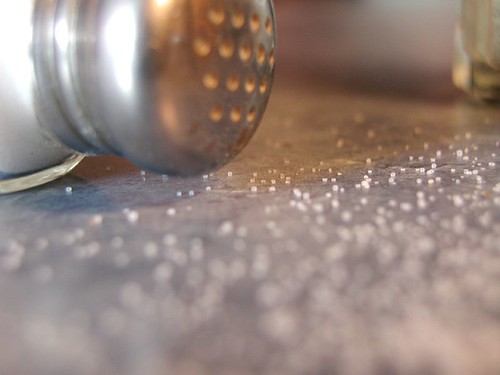Salt, or the chemical term sodium chloride, has been so highly prized in our history that it has been used as currency and as a strategy to wage war. Salt rations that were given to Roman soldiers were known as salarium, an early term that became the word salary that we use today. Why did something as simple as salt come to have such power?
First of all, our bodies need salt to survive. We each begin our very existence buoyed in a saline bath of amniotic fluid and then continue to seek this briny taste in foods. While the average healthy person needs only about 1,200 – 1,500 milligrams (mg) of sodium per day, we consume far more, closer to 3,400 mg per day. To put these amounts into perspective, one teaspoon of salt contains about 2,000 mg of sodium.
Saltiness
Why are we eating so much salt? A good portion of the sodium that we consume comes from processed foods. Consider that anything you purchase at the supermarket that comes in a bag, a can, a box, a bottle, etc. most likely has some amount of sodium in it. These items all add up. Then if we add salt from the salt shaker to foods at the table or while cooking at home and meals at restaurants, the amount of salt we consume quickly adds up even more.
Key Recommendation
We know that decreasing sodium intake can help to reduce blood pressure in both children and adults. High blood pressure or hypertension is a risk factor for heart disease and stroke and more and more children and adolescents are being diagnosed with hypertension. Due to this, sodium is the number one food component to reduce in our diets, according to the Dietary Guidelines for Americans 2010. The key recommendation is to reduce sodium intake to less than 2,300 mg per day and to further reduce intake to 1,500 mg per day for people who are 51 and older and those of any age who are African American or have hypertension, diabetes, or chronic kidney disease. This amounts to about half of the United States population, including children over the age of 2 and adults, who can benefit from reducing their daily sodium intake to 1,500 mg.
How To Tips
With the widespread use of sodium in processed foods, it can seem daunting to reduce the amount of sodium we eat to 2,300 mg per day, never mind the 1,500 mg per day recommended for half of all people in the United States! Even though we seem to like the taste of salt in our foods, the good news is that we can get used to the taste of less salt and may not even notice small, gradual changes. Here are some ‘how to’ tips on reducing the amount of sodium in your diet:
- Take the salt shaker off the table at home, put it away, and keep it there.
- Use fresh herbs, spices and other seasonings to add flavor when cooking. Try garlic, ground pepper, lemon and lime juices, onions, vinegars, basil, parsley, oregano, hot or bell peppers.
- While shopping, use the Nutrition Facts label on packaged foods to compare the amount of sodium and choose those lower in sodium.
- Use Guiding Stars’ Food Finder – Foods and beverages with Guiding Stars follow the highest scientific recommendations for sodium and are the most nutritious.
- Follow the Dietary Approaches to Stop Hypertension or DASH eating plan. Studies have shown that following this plan can significantly reduce blood pressure. It emphasizes fruits, vegetables and low-fat dairy foods and is low in saturated fat and cholesterol. The plan includes sample menus and recipes.
- Eat more whole, fresh foods such as:
- fruits and vegetables
- fat-free and low-fat milk and dairy foods
- whole grain foods
- lean meats, fish and poultry
- nuts, seeds, dried beans and legumes
- liquid oils such as olive and canola
Final Thoughts
This is a great time to work towards reducing your sodium intake as many major food companies have pledged to reduce the amount of sodium in processed and restaurant food across the United States by 25% over the next 5 years through the National Salt Reduction Initiative (NSRI). The NSRI partnership was started by New York City public health officials and the newest members committed to this initiative include Campbell Soup Company, Ken’s Foods and Target Corporation. Delhaize America, the parent company of Hannaford, Food Lion, Bloom and Sweetbay supermarkets, and where you can find Guiding Stars in action in those stores, is already committed to NSRI targets.
About our Nutrition Expert
Lori Kaley MS, RD, LD, MSB is a member of the Guiding Stars Scientific Advisory Panel. Lori has 30 years of combined experience working in healthcare and public health creating policies and environments to help families and children have access to healthy foods and beverages. She is currently Policy Associate at the University of Southern Maine’s Muskie School of Public Service.
Lori’s greatest achievement and joy has been in raising her three daughters to be healthy and productive young adults, each with their own particular love of food, cooking and being physically active. Lori’s passion for nutritional community outreach has been a cornerstone of the Guiding Stars Scientific Advisory Panel. Lori regularly contributes to the Guiding Stars blog.
